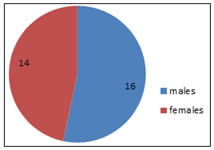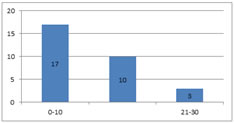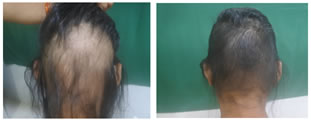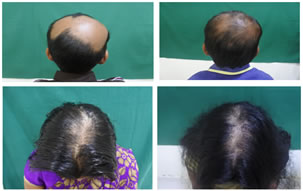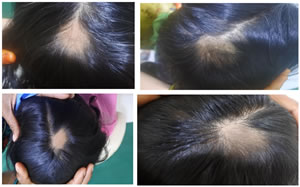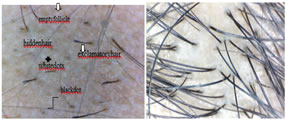|
Table of Content - Volume 20 Issue 2 - November 2021
Efficacy of triple combination mesotherapy with (triamcinolone acetonide, adipose derived stem cells extract and growth factors and aminoacids, vitamins and biomimetic peptide complex) in patients of alopecia areata
Sreevidya V1, M Madhavi Latha2*, T Praveena3
1Post Graduate, 2Professor, 3Associate Professor, Department Of DVL, Santhiram Medical College & General Hospital, NH-40, Nandyal, Andhra Pradesh, INDIA. Email: vidya7850@gmail.com, vc.madhavi@gmail.com, praveenathiriveedhi@gmail.com
Abstract Background: Alopecia areata is an autoimmune, chronic inflammatory disease that causes non-scarring hair loss of scalp and body hairs. It affects 1% of the general population. Genetic, environmental, and autoimmune factors are considered to play most possibly a role in its etiology. Alopecia areata is a T cell-mediated organ-specific autoimmune disease. Aims And Objectives: To determine the efficacy of Mesotherapy with Triamcinolone acetonide, Adipose-derived stem cells extract and growth factors and amino acids, vitamins, and biomimetic peptide complex. Methods: An observational prospective study was conducted from November 2020 to April 2021 with a total of 30 patients with alopecia areata on the scalp to the department of DVL, OPD; Santhiram medical college and general hospital, Nandyal. A detailed history was taken in a prestructured proforma. A thorough clinical cutaneous and scalp examination was done. Results: The earliest age of onset recorded was eight years. The vertex region of the scalp was most commonly involved, followed by the frontal area. Dermatoscopy findings were empty follicles 53.3%, white dots 43.3%, exclamatory mark 6.6%, hidden hair 46.6%, black dots 33.3%, broken hair 16.6% , kinky hair 6.6% , bent hai13.3%. Association with other diseases were seen as atopy 5 (16.6%) thyroid disorders 16(53.3%). Access to SALT score 17 (56.6%) showed significant improvement, 10 (33.3%) showed moderate improvement, 3 (10%) showed poor improvement. Conclusion: scalp was the most common site affected with the vertex area being the most common region. Alopecia areata was commonly Associated with atopy, Thyroid disorders. Mesoneedling with Triamcinolone acetonide, Adipose-derived stem cells extract and growth factors and amino acids, vitamins, and biomimetic peptide complex has a significant benefit in converting vellus hairs to terminal hair. It has the potential to become a therapeutic modality of treatment in recalcitrant alopecia areata. Key words: Alopecia areata (AA), Mesoneedling, Triamcinolone acetonide (TA), black dots (BD).
INTRODUCTION Alopecia areata is an autoimmune, chronic inflammatory disease that causes non‐scarring hair loss. It is estimated to be presenting a complaint in 1% of new dermatological consultations. Genetic, environmental, and autoimmune factors are considered to play most possibly a role in its etiology. Alopecia areata is a T cell-mediated organ-specific autoimmune disease, associated with various autoimmune disorders such as vitiligo, atopy, thyroid disorders, diabetes mellitus. Dermatoscopy active disease is characterized by yellow dots, black dots, exclamation marks, broken hairs, hidden hair, white dots, bent hair, kinky hair. Histopathology: the swarm of bee's appearance due to dense peribulbar lymphocytic infiltrates, characterize the acute phase of A.A. Mesotherapy is a non-surgical, minimally invasive method of drug delivery that consists of multiple intradermal or subcutaneous injections of pharmaceutically active substances in low doses, at numerous points, near/over affected sites at longer time intervals than conventional routes. Once the drug is administered it achieves a longer-lasting effect and a great local bioavailability. The injectable blend for Meso needling contains Triamcinolone acetonide, Adipose-derived stem cells extract, and growth factors and amino acids, vitamins, and biomimetic peptide complex. AIMS AND OBJECTIVES: To determine the efficacy of Mesotherapy with Triamcinolone acetonide, Adipose-derived stem cells extract and growth factors and amino acids, vitamins, and biomimetic peptide complex.
MATERIALS AND METHODS An prospective observational study was conducted from November 2020 to April 2021 with a total of 30 patients with Alopecia areata on the scalp to the department of DVL, OPD, Santhiram Medical College and General Hospital, Nandyal. Patients willing to give consent were included in the study. uncooperative patients or Patients who are unable to understand the protocol and give written and informed consent were excluded. A detailed history was taken in a prestructured proforma. A thorough clinical cutaneous and scalp examination was done. Digital photographs of lesions and trichoscopic images were taken. The salt score calculated the entire scalp was divided into 4 areas: vertex (40%), Right profile of scalp (0.18%), left profile of scalp (0.18%), posterior aspect of the scalp (24%) based on the area involved, assigned a score according to the percentage of hair loss in each area. we calculated the severity of the alopecia tool score for each patient by taking the sum of the four representatives sites scores. thus maximum attainable score for a patient was 30. we graded the objective scores as mild (score of 0-10), moderate (score of 11-20), severe (score of 21-30). The area to be treated is cleaned, 5ml syringe is loaded with Triamcinolone acetonide(1ml), growth factors and amino acids, vitamins, biomimetic peptide complex (1ml), adipose-derived stem cells extract (1ml). mesoneedling was done over the affected area, by using derma pen, multiple tiny punctures were made, the triple combination was infiltrated over the patches, observed for immediate and late side effects .this procedure was for done every month for 6 months. Assessment of hair growth was done for every session.
RESULTS This study sample consists of 30 patients, out of which 16 were males, 14 were females. The majority were belonging to the age groups 21-30 yrs. the earliest age of onset recorded was eight years. Alopecia areata was associated with diseases, atopy 5 (16.6%), thyroid disorders 16 (53.3%). the scalp’s vertex regions were most commonly involved .3 (10%) had mild improvement,10(33.3%) showed moderate improvement 17 (56.6%) showed significant improvement. Dermatoscopy findings were white dots in 56.2%, empty follicles in 42.2%, yellow dots 40.2%, broken hair 20%, exclamatory mark 10%, hidden hair 50%, black dots 33.3%, kinky hair 10%, bent hair 6.6%. Figure 1: Male and female distribution
Table 1: Age distribution
Table 2: Sex distribution
Table 3: Distribution of patches
Table 5: Association with other diseases
Table 6: Dermatoscopic changes in AA
The severity of alopecia tool score: before treatment Salt score was calculated, the entire scalp was divided into 4 areas: vertex (40%), Right profile of scalp (0.18%), left profile of scalp (0.18%), posterior aspect of the scalp (24%) based on the area involved, assigned a score according to the percentage of hair loss in each area. we calculated the severity of the alopecia tool score for each patient by taking some of the four representatives sites scores. thus maximum attainable score for a patient was 30. we graded the objective scores as mild (score of 0-10), moderate (score of 11-20), severe (score of 21-30)
Figure 2: Salt score before treatment The severity of alopecia tool score: combination of triamcinolone acetonide, adipose-derived stem cells extract and growth factors and amino acids, vitamins, biomimetic peptide complex.
Figure 3: After 6 months of treatment Assessment of hair regrowth upto 30% mild, 30-60% moderate response, > 60% significant response.
Figure 4
Figure 5: Before treatment
Figure 6: After treatment
Figure 7 Figure 8
DISCUSSION Alopecia areata is a chronic inflammatory disease causing a non-scarring form of hair loss. AA affects both sexes equally though in some studies there was preponderance for males. our study included 30 patients of alopecia areata of both sexes of which 53.3% were males and46.6% were females. Several therapies are tried in alopecia areata, few showed significant improvement while others had relapses. Mesoneedling needling therapy with the triple combination of Triamcinolone, adipose-derived stem cells extract and growth factors and amino acids, vitamins, biomimetic peptide complex. showed significant improvement with limited side effects. According to Suresh H Deepak et al., three patients (1 female and 2 males) with alopecia areata, showed 50-70% improvement. In our study Mesoneedling with triple combination therapy after 6 sessions, 56.6% of patients showed significant improvement, 23.3% showed moderate improvement in treated areas. A hair follicle is the reservoir of epithelial stem cells. Meso needling stimulates the dermal papillae and stem cells in a hair follicle that releases epidermal and platelet derived growth factors which causes hair growth Cocktail solutions increase local microcirculation, provide nutritional input, stimulates the hairs environment through micro-needling, and complement other treatments It allows a painless skin perforation and provides uniform delivery of therapeutic molecules into the scalp by creating microchannels. Scalp roller breaks down the dermal capillaries and platelets begin to form a plug at the site of the damage to temporarily and release the chemotactic factors /growth factors, helps in stimulation of hair growth.
CONCLUSION Mesoneedling with Triamcinolone acetonide, Adipose-derived stem cells extract, growth factors and amino acids, vitamins, biomimetic peptide complex have a significant benefit in converting vellus hairs to terminal hair. It has the potential to become a therapeutic modality of treatment in recalcitrant alopecia areata.
REFERENCES
Policy for Articles with Open Access
|
|
 Home
Home
